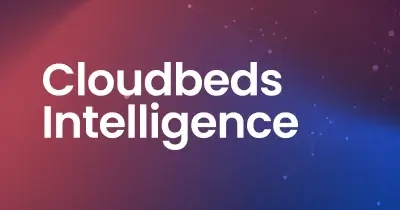
By Cloudbeds
Cloudbeds recently launched Cloudbeds Payments, a fully integrated payments solution and terminals built into our hospitality management platform. I’ve already spent some time going over the benefits of using Cloudbeds Payments – drastically reduced manual errors and reconciliation times, lower labor costs and merchant processing fees, fast payout, an in-house dispute management team, modern terminals, and more.
Today, I want to dig into Cloudbeds Payments’ processing and how we have you covered when it comes to protecting your business against fraud, chargebacks, and security headaches.
How Cloudbeds makes sure your payments are secure
Payment security is an important topic because fraud has shot up during the Covid pandemic due to the absence of face-to-face transactions. The hospitality industry is an easy target for fraud because of the long time periods between when a booking is made (and the deposit paid) and when the stay actually happens. Because of this holding period, lodging businesses often face “friendly fraud” – or payment disputes that happen when the consumer doesn’t remember the charge or doesn’t like the service. To add another layer of complexity, sometimes guests book with one payment method but use another to pay the transaction once they arrive.
To combat the unique type of fraud facing our community, Cloudbeds sends hospitality-enriched data (for example, the dates when a guest’s stay starts and when it ends) to the bank’s incremental authorizations (more on this later). We’ve built Cloudbeds Payments specifically for hospitality. Because of this, we can handle disputes much more effectively on behalf of the merchant because the hospitality-enriched data gives us a better footing and more evidence to win disputes. This extra layer of protection is not something you get if you use a third-party gateway.
Another way we protect your payments is by assigning a risk assessment score to a transaction. Using machine learning technology and Artificial Intelligence (AI), we’ve developed a way to associate a payment method to a user using info such as purchasing behavior and payment history. Using the data, we create a user profile or “fingerprint” that associates the user with their card and gives the card a risk-assessment score. The score is assigned based on past behavior. For example, does the card have a history of chargebacks? Has it been reported lost or stolen? etc. All of these variables get passed to our customers in real-time and help us more accurately identify fraud.
Here’s a summary of how Cloudbeds protects and supports your payment transactions:
- We’ve built a leading payment system that watches for transactional fraud using a card’s “fingerprint” (based on payment history and purchase behavior) to deliver a risk-assessment score to our customers in real time.
- Cloudbeds Payments is built specifically for hospitality. We send hospitality-specific data from the transaction to the issuing bank to increase the likelihood that the transaction will be approved and decrease the likelihood that you’ll lose a chargeback dispute.
- We have an in-house support team that handles disputes for you. Our goal is for our customers to not even have payments denied, but in the event that it happens, we have a support team to handle it for you.
- For EU- Tech is linked between the payment system and the PMS system to give our customers the ability to manage. We are experts, we make life easier.
As hospitality experts and fellow owners and operators, we at Cloudbeds know the unique pain points facing our community and the frustrations of dealing with large payment gateway providers. We’ve built Cloudbeds Payments in a way that addresses industry-specific issues and empowers hoteliers and hosts to hold a stronger position in the payment processing space that traditionally favors card brands and banks.
What’s the difference between PSD2, SCA, and 3DSecure?
Cloudbeds Payments are securely stored, fraud protected, and compliant with the European Union’s PSD2, Strong Customer Authentication, and 3D Secure requirements.
So, what does that mean exactly? Let me explain:
PSD2 – Payment Service Directive 2 is a European-wide standard. It’s the regulation that requires the use of Strong Customer Authentication (a second means to verify a charge) to make online website payments safer and reduce fraud. The United States typically uses a person’s zip code as an enhanced security measure.
3D Secure – 3-domain security was developed by big credit card companies to combat online fraud. With 3D Secure, the issuer (bank) requires that the user take some sort of action to approve the transaction (via notification, text, etc.), or else the payment will be rejected. 3D Secure 2.0 is optimized for mobile and also supports risk-based authentication, as every transaction does not require the 3DS process. This is possible because of the enriched data that is sent to the issuer in the 3DS 2.0 framework. With 3D Secure, owners and operators are more likely to get payment approval, and it’s less likely for the guest to have a bad experience; plus, in most cases, it shifts liability to the bank.
Strong Customer Authentication (SCA) – Not all transactions and not all banks require 3D Secure. For this reason, the European Union wants to enact Strong Customer Authentication, so guests have a second method of authorizing a charge. With SCA, guests will need two out of three authentication factors to authorize payment:
- Something only the guest knows – Like a PIN, code, or password
- Something only the guest possesses – Like a physical payment card or mobile phone
- Something the guest is – Biometric information like a face ID, fingerprint, or an iris scan
The big deal about Cloudbeds Payments is – it’s not a big deal! That’s because we take care of compliance, risk assessment, and credit card disputes for you.
Why are integrated payments so important for your business?
Even though PSD2 is a European-specific standard, Cloudbeds fully supports security globally. If you don’t have integrated payments, then there is the potential for payment processing to be a massive overhead for you.
To illustrate, let’s say by policy, your property charges a 50% deposit fee seven days before the check-in date, and the guest books their stay two months in advance. If the guest never approved the 3D Secure transaction and arrived at your property without being charged the deposit, or if they don’t show up at all, your property can’t charge the guest’s card, and you can lose out on your payment. You would have to be constantly vigilant to decide when you should cancel an unpaid booking so you can put the room back on the market.
With Cloudbeds Payments, we keep your guest and payment data all in one place. You can see the status of the reservation, you can change your policy, and you have enough time and information to request 3D Secure authorization so you can either contact the customer if their payment doesn’t go through or cancel the reservation and make the accommodation available for others to book.
You have to have precise alignment between your PMS and payment processor to manage all your transactions, or else you may lose revenue. We focus on aligning payments for you.


















